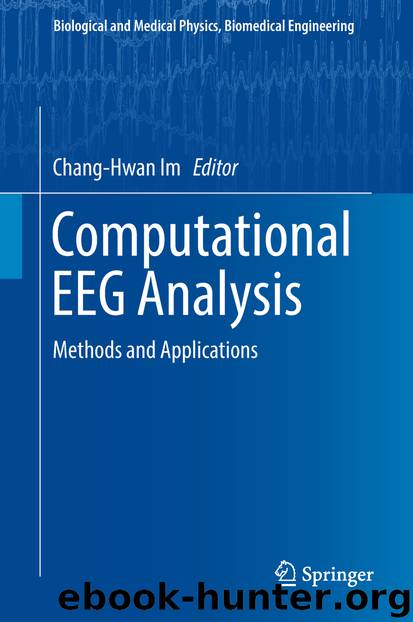Computational EEG Analysis by Chang-Hwan Im

Author:Chang-Hwan Im
Language: eng
Format: epub
ISBN: 9789811309083
Publisher: Springer Singapore
Model-based approaches, on the other hand, are founded upon the development of realistic models of the biological and physical factors that give rise to the detected BOLD and EEG signals [71]. In general, this means that data-driven approaches are simpler and better suited to naïve cases while model-driven approaches are more conceptually complete and informative, albeit with an increased computational cost. It also means that model-based approaches require a somewhat deeper understanding of the factors connecting EEG to fMRI. For example, we have established that neurovascular coupling as the underlying mechanism that connects the EEG and fMRI modalities. This coupling is not constant, however—decoupling between the BOLD and EEG signals can be informative depending on the situation. Decoupling has been observed in a variety of specific cases, including decoupling in the frontal lobe during locomotion and in cases of cerebral amyloid angiopathy [67] or seizure [75]. An ideal model will also need to deal with the dynamics of whole neuronal populations and once again address how these dynamics are represented at the scalp level. These populations may show complex activity, including both inhibitory and excitatory interactions within context of a population firing pattern that may be conditionally rhythmic or transient. True neurophysiologic models are then difficult to generate; the core principles for them are highly complex and any errors will be amplified as the model is built outward from the cell populations and their properties [71]. Thankfully, our current discussion has provided a firm basis in EEG source localization and reconstruction, which accounts for one major aspect of neurogenerative modelling.
The general pattern of the forward model and inverse problem, as explored above, reappears here. Forward models will serve to represent the processes that generate EEG and fMRI data while the inverse calculation will identify the model conditions responsible for observed data [42]. Early single and double columnar models of neuronal population activity were generated following a biological representation of excitatory pyramidal cells modulated by inhibitory interneurons and excitatory stellate cells [43]. This method proved to be effective at reproducing a variety of oscillating and spiking patterns that closely resembled experimental data. The model has since been expanded to cover a single or multiple cortical areas with the added context of hemodynamic coupling [4, 5]. While these models have shown a remarkable amount detail, it will be easier to illustrate the overall process of neurogenerative modelling using simpler approaches, such as that presented by Buxton et al. in 2004 [14], which modeled the total neural activity as the difference between excitatory and inhibitory inputs in the following equations:
Download
This site does not store any files on its server. We only index and link to content provided by other sites. Please contact the content providers to delete copyright contents if any and email us, we'll remove relevant links or contents immediately.
The Complete Stick Figure Physics Tutorials by Allen Sarah(7258)
Secrets of Antigravity Propulsion: Tesla, UFOs, and Classified Aerospace Technology by Ph.D. Paul A. Laviolette(5232)
Thing Explainer by Randall Munroe(3842)
The River of Consciousness by Oliver Sacks(3490)
The Order of Time by Carlo Rovelli(3091)
How To by Randall Munroe(2962)
A Brief History of Time by Stephen Hawking(2904)
I Live in the Future & Here's How It Works by Nick Bilton(2896)
The Great Unknown by Marcus du Sautoy(2609)
What If?: Serious Scientific Answers to Absurd Hypothetical Questions by Randall Munroe(2582)
Midnight in Chernobyl by Adam Higginbotham(2427)
Blockchain: Ultimate Step By Step Guide To Understanding Blockchain Technology, Bitcoin Creation, and the future of Money (Novice to Expert) by Keizer Söze(2404)
Networks: An Introduction by Newman Mark(2298)
The Meaning of it All by Richard Feynman(2263)
Easy Electronics by Charles Platt(2245)
The Tao of Physics by Fritjof Capra(2198)
Midnight in Chernobyl: The Untold Story of the World's Greatest Nuclear Disaster by Adam Higginbotham(2122)
When by Daniel H Pink(2053)
Introducing Relativity by Bruce Bassett(2042)
